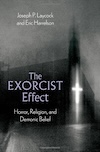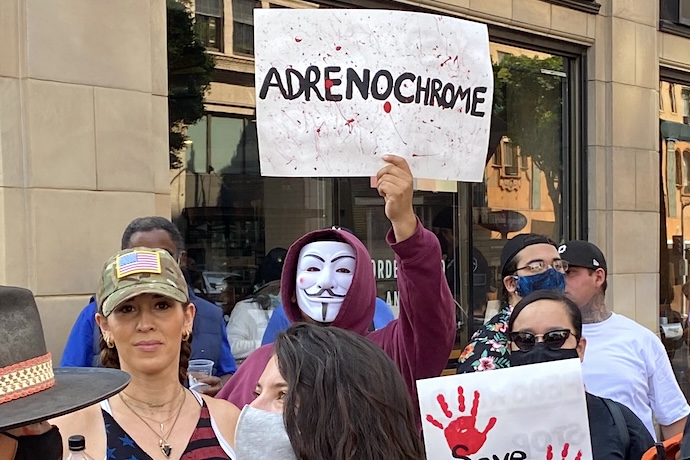What inspired you to write The Exorcist Effect?
Over twenty years ago, Michael Cuneo wrote a book called American Exorcism, arguing that William Friedkin’s The Exorcist had almost single-handedly brought about a revival of exorcism in America. We think Cuneo was generally correct, but it’s hard to actually prove this claim. In fact, one acquisitions editor who approached us to write “something” about exorcism told us he was no longer interested in our project because it was impossible to demonstrate a causal connection between horror films and supernatural belief.

The Exorcist Effect: Horror, Religion, and Demonic Belief
Joseph P. Laycock and Eric Harrelson
Oxford University Press
Nov 7, 2023
What’s the most important take-home message for readers at this cultural moment?
Some of the cases of moral panic we examined in this book were disturbing: “recovered memories” of satanic ritual abuse that were clearly scenes from The Exorcist and The Omen; psychiatrists forcing their patients to undergo exorcisms; tropes from horror movies that shaped the trial of The West Memphis Three (popularized in the 1996 documentary, Paradise Lost: The Child Murders at Robin Hood Hills); QAnon claims about torturing children to harvest “adrenochrome” or Hillary Clinton wearing a child’s face like a mask. These cases show what’s at stake when we use horror movies to interpret the real world.
In cases like the West Memphis Three, where three young boys were murdered, it seemed that the fear, anger, and sadness experienced after a horrible and seemingly inexplicable tragedy were weaponized by authorities and opportunists to produce a simple, tidy explanation—that the murders had been part of a satanic ritual—rather than address the actual underlying causes. The ensuing scapegoating often takes its cues from horror films, as it’s easier to blame some imagined force of evil than to accept a member of your community is capable of deliberately committing such an unthinkable act. As Hannah Arendt observed, real world evil is often banal and rarely resembles movie villains.
Is there anything you had to leave out?
There are a lot of horror movies out there and we couldn’t cover everything. While we were able to give some coverage to foreign films, we focused primarily on American films and North American culture. There is definitely more work to be done to analyze the relationship between religion and horror in places like Japan, Korea, Turkey, and Iran.
What are some of the biggest misconceptions about your topic?
We really hope no one thinks we are advocating censorship. We view censoring movies or books or music as a reactionary move that doesn’t address the core issues of the problems it purports to solve. Furthermore, stigmatizing film, music, and other art can actually lead to more harm perpetrated on innocent people. Instead of censorship, we advocate for media and information literacy, along with better critical thinking skills.
Additionally, readers may think we are out to “debunk” the existence of the supernatural. Our goal is not to prove that there are no demons or ghosts or whatever. But some beliefs do need to be questioned. For example, it is harmful to believe someone is guilty of murder because they “look like a Satanist” from a horror movie.
Did you have a specific audience in mind when writing?
We hope film scholars as well as religion scholars will appreciate some of the information we found in the archives and through interviews. For example, we discovered a lot of cool stuff about figures like the Warrens, who inspired the Conjuring film series, and Malachi Martin, a former Jesuit who lied incessantly about his knowledge of exorcism. We’re also both horror fans and we think other fans will be curious about how their favorite movies influenced not just entertainment, but folklore, religious practices, and even psychiatry.
Fans of “true crime” may also enjoy some of the connections we discovered. For example, David Berkowitz, the Zodiac Killer, and Jeffrey Dahmer all tried to capitalize on “The Exorcist” franchise, either to get attention or build a defense. We also analyze the trial of Arne Johnson, in which Ed and Lorraine Warren attempted to argue Johnson was not guilty of murder by reason of demonic possession.
Are you hoping to just inform readers? Entertain them? Piss them off?
We think the information in this book is interesting and fun to read, but there’s also a point to it. “The Exorcist Effect” has contributed to some destructive outcomes that have ruined lives. The greatest of these was The Satanic Panic, a conspiracy theory that was rendered more plausible in the 1980s after cable television put films like Rosemary’s Baby, The Exorcist, and The Omen into heavy rotation.
So we hope this book encourages readers to think about the power of media. We need to find ways to get the public to think more critically about these topics and to question where their assumptions about things like demons and Satanic cults come from. We all need to take a cue from marketing materials for Wes Craven’s 1972 breakthrough horror film The Last House on the Left and remind ourselves: “It’s only a movie. It’s only a movie.”
What alternative title would you give the book?
We homed in on “The Exorcist Effect” pretty quickly. The hard part is deciding what to put after the colon. We looked at “How Horror and Religion Shape Each Other” but decided this was too vague. We finally settled on “Religion, Horror, and Demonic Belief” to signal what you can expect to find in this book.
How do you feel about the cover?
We wanted to evoke the classic Exorcist movie poster, which has been parodied and pastiched in so many subsequent films and other visual media. In the 1970s, black and purple were the signature colors of the advertising campaign for the book and film. We decided on the image of a spooky church to signal that this is still a book about the American religious landscape.
Is there a book out there you wish you had written? Which one? Why?
Well obviously, American Exorcism by Michael Cuneo since that book began the process of connecting The Exorcist to contemporary exorcism culture. We were also really impressed with Flicker: Your Brain on Movies by neuroscientist Jeff Zacks. Zacks’s findings on how movies affect memory and our models for reality have disturbing implications for horror movies.
What’s your next book?
We found more about Ed and Lorraine Warren than we could fit in one chapter and Eric may do a follow up project on the Warrens. Joseph is currently looking for a publisher for a new project on the reptilian conspiracy theory.
Is there anything else you’d like our readers to know about your book?
Much like William Friedkin, we would like to inform the media that our project is cursed. We have heard that despite having a local priest come out to bless the printing presses, six employees of the publishing house were injured during printing. It has also been said that a delivery truck carrying the first hard copies of the book was involved in a dangerous accident. The driver reportedly lost control of the vehicle and ran down an embankment. The truck rolled several times before coming to a stop just before a sharp 25-foot drop. The driver luckily escaped with only a few broken fingers and some 13 stitches. He reported seeing a large black dog with glowing red eyes standing in the road and swerved to avoid hitting it.
A curse may explain why this book took nearly five years to write and why our research trip to Connecticut to see the Annabelle doll went over budget. Readers have been warned.





